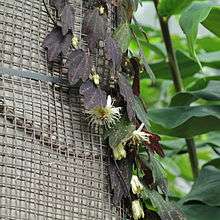Passiflora telesiphe
| Passiflora telesiphe | |
|---|---|
 | |
| at Kew Gardens | |
| Scientific classification | |
| Kingdom: | Plantae |
| (unranked): | Angiosperms |
| (unranked): | Eudicots |
| (unranked): | Rosids |
| Order: | Malpighiales |
| Family: | Passifloraceae |
| Genus: | Passiflora |
| Species: | P. telesiphe |
| Binomial name | |
| Passiflora telesiphe S.Knapp & Mallet | |
Passiflora telesiphe is a species of flowering plant in the family Passifloraceae. It is endemic to Ecuador.[1]
This is a vine with slender branches. The three-lobed leaves are up to 8 by 11 centimeters. The upper surface of the leaf is dark green, sometimes mottled with white, and the underside is purple. The flowers are solitary or paired with purple-tinged white petals. The filaments are white or purplish and are up to 2.6 centimeters long. The fruit has not been observed.[2] This species is a member of the subgenus Decaloba.[2]
This plant was first described to science in 1998. It was discovered in Ecuador during a 1993 observation of local butterfly fauna. A male telesiphe longwing (Heliconius telesiphe) was noted hovering about a plant, and the eggs and pupae of the species were found on it. The new plant was then named after the butterfly.[2]
So far this plant is known only from Zamora-Chinchipe Province. It is found in low Andean forest habitat at around 1700 meters in elevation.[1]
References
| Wikimedia Commons has media related to Passiflora telesiphe. |
- 1 2 Jørgensen, P. & Pitman, N. 2004. Passiflora telesiphe. The IUCN Red List of Threatened Species. Downloaded on 20 February 2016.
- 1 2 3 Knapp, S., and J. Mallet. 1998. A New Species of Passiflora (Passifloraceae) from Ecuador with notes on the natural history of its herbivore, Heliconius (Lepidoptera: Nymphalidae: Heliconiiti). Novon 162-166.
